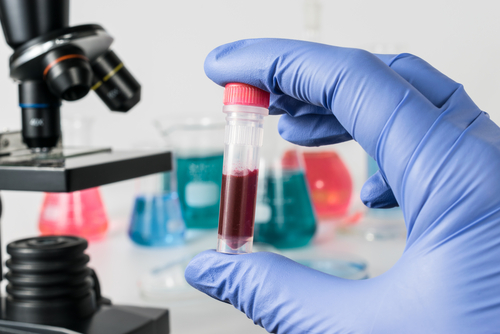Anti-inflammatory Therapies May Alter Disease Course in Patients With Early-onset Parkinson’s, Study Suggests

People with early-onset Parkinson’s disease caused by mutations in the PRKN or PINK1 genes have high levels of the pro-inflammatory immune signaling protein interleukin-6 and mitochondrial DNA in the blood, which may serve as markers of disease state and progression, a study revealed.
According to the researchers, the findings suggest that anti-inflammatory therapies may influence the course of Parkinson’s, at least in this sub-group of patients.
Their findings were described in the study, “Mitochondrial damage-associated inflammation highlights biomarkers in PRKN/PINK1 parkinsonism,” published in the journal Brain.
Early-onset Parkinson’s can be caused by mutations in the PRKN and PINK1 genes, which provide instructions to make two proteins — parkin and PINK1 — that play an essential role in mitochondria recycling, a process known as mitophagy. Mitochondria are the energy-producing centers in cells.
Mutations that lead to impaired mitophagy cause the release of mitochondrial DNA (mtDNA), which triggers inflammation by activating an immune response.
This process of inflammation can be measured by assessing the blood levels of interleukin-6 (IL-6) — a pro-inflammatory signaling protein (cytokine) that has been found to be elevated in serum samples from patients with Parkinson’s.
However, the role of IL-6 and cell-free mtDNA in individuals with PRKN and PINK1 mutations, compared with unaffected people or patients with idiopathic (of unknown cause) Parkinson’s, remains unclear.
To learn more, researchers at the University of Lübeck in Germany and their colleagues collected blood samples from 245 people to measure the levels of IL-6, mtDNA, and C-reactive protein (CRP), a standard marker of inflammation.
Of those who participated, 15 patients carried mutations in both copies (homozygous) of either PRKN or PINK1 genes, 19 had mutations in just one copy of these genes (heterozygous), and 15 were unaffected heterozygous carriers, meaning they had mutations in one copy of the genes but did not show signs of Parkinson’s.
The study also included 59 patients with idiopathic Parkinson’s and 90 mutation-free healthy control subjects. A total of 45 IL-6 samples, retested from a previous study, also were included.
Analyses revealed that patients with Parkinson’s who carried mutations in both gene copies had significantly higher IL-6 levels compared with healthy control subjects, and higher levels compared to both affected and unaffected heterozygous mutation carriers.
Compared with healthy controls, heterozygous mutation carriers also had higher IL-6 levels.
“This tells us that heterozygous mutations also constitute a strong risk factor for the onset of Parkinson’s disease,” Anne Grünewald, PhD, a senior author of the study, said in a press release.
“Even before the disease has broken out in these heterozygous carriers, we might be able to detect it at an early stage by monitoring IL-6 in the serum,” Grünewald said.
To confirm these results, the team also performed the same analyses in a group of patients from Italy that included 19 homozygous PRKN or PINK1 mutation carriers, five affected heterozygous, and nine unaffected heterozygous carriers, as well as five patients with idiopathic Parkinson’s and nine healthy control subjects.
Similarly, homozygous mutation carriers had significantly higher IL6 levels compared with healthy controls and unaffected heterozygous mutation carriers. Affected heterozygous mutation carriers also tended to have higher levels of IL-6 compared with healthy people. In contrast, unaffected heterozygous mutation carriers did not have higher IL-6 levels.
Investigators also found patients with idiopathic Parkinson’s had significantly higher IL-6 levels than controls, but not as high as homozygous mutation carriers.
While CRP levels did not generally match the IL-6 results, there was a trend toward increased CRP in patients with Parkinson’s caused by PRKN or PINK1 mutations, compared with those with idiopathic disease or healthy controls. CRP levels correlated with IL-6 in affected PRKN or PINK1 mutation carriers, patients with idiopathic Parkinson’s disease, and healthy subjects.
Compared with patients with idiopathic Parkinson’s, there was a significant increase in mtDNA in homozygous mutations carriers and affected heterozygous mutation carriers.
There also was a trend toward elevated mtDNA in homozygous carriers and affected heterozygous individuals compared with controls. Furthermore, high mtDNA levels were found in affected compared with unaffected heterozygous mutation carriers.
Additional analyses also showed that mtDNA levels could distinguish patients with idiopathic disease from those whose Parkinson’s was associated with heterozygous PRKN or PINK1 mutations.
Researchers also found that in patients with idiopathic Parkinson’s, older subjects tended to have higher IL-6 levels; however, this trend was not found in homozygous mutation carriers or in healthy controls. Higher levels of IL-6 correlated with longer disease duration in those with homozygous mutations, but not in those with idiopathic disease.
“These results highlight the potential of IL-6 as progression marker in Parkinson’s disease due to PRKN/PINK1 mutations,” they wrote.
After adjusting for age, trends in IL-6 levels remained, which also highlighted the differences in IL-6 levels in affected homozygous mutation carriers compared with affected heterozygous individuals and patients with idiopathic disease.
Given this connection between PRKN or PINK1 mutations and inflammation, “our study suggests that treatment with anti-inflammatory drugs holds the potential to alleviate the course of Parkinson’s disease — at least for patients with mutations in the Parkin or PINK1 gene,” Grünewald said.
“Our findings have a high value for potential clinical applications, be it biomarkers in the patient’s serum that detect the state of the disease or new therapeutic approaches targeting the innate immune response in Parkin/PINK1-associated Parkinson’s disease,” she added.






